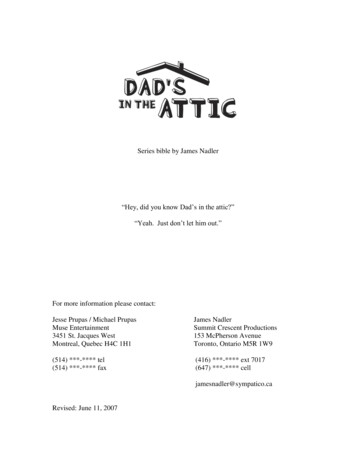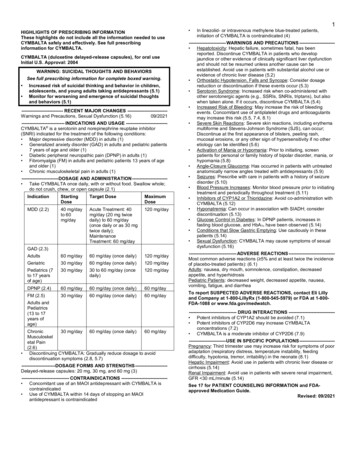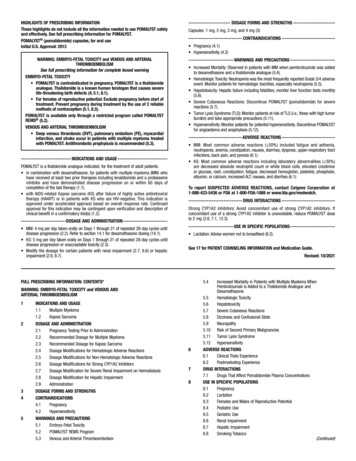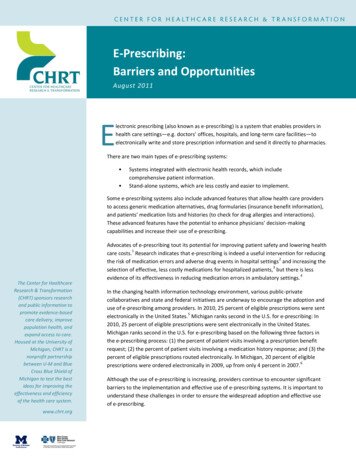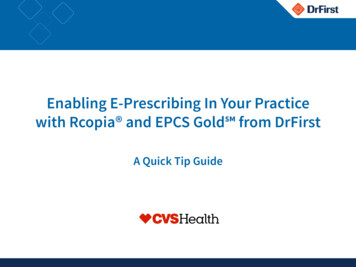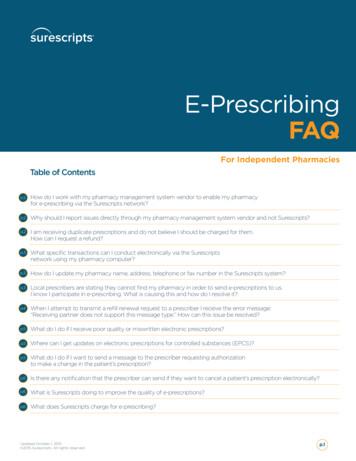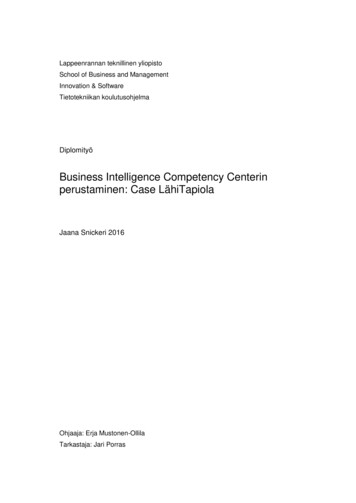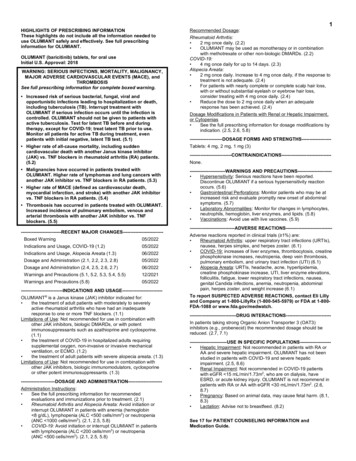
Transcription
1HIGHLIGHTS OF PRESCRIBING INFORMATIONThese highlights do not include all the information needed touse OLUMIANT safely and effectively. See full prescribinginformation for OLUMIANT.OLUMIANT (baricitinib) tablets, for oral useInitial U.S. Approval: 2018WARNING: SERIOUS INFECTIONS, MORTALITY, MALIGNANCY,MAJOR ADVERSE CARDIOVASCULAR EVENTS (MACE), andTHROMBOSISSee full prescribing information for complete boxed warning. Increased risk of serious bacterial, fungal, viral andopportunistic infections leading to hospitalization or death,including tuberculosis (TB). Interrupt treatment withOLUMIANT if serious infection occurs until the infection iscontrolled. OLUMIANT should not be given to patients withactive tuberculosis. Test for latent TB before and duringtherapy, except for COVID-19; treat latent TB prior to use.Monitor all patients for active TB during treatment, evenpatients with initial negative, latent TB test. (5.1)Recommended Dosage:Rheumatoid Arthritis: 2 mg once daily. (2.2) OLUMIANT may be used as monotherapy or in combinationwith methotrexate or other non-biologic DMARDs. (2.2)COVID-19: 4 mg once daily for up to 14 days. (2.3)Alopecia Areata: 2 mg once daily. Increase to 4 mg once daily, if the response totreatment is not adequate. (2.4) For patients with nearly complete or complete scalp hair loss,with or without substantial eyelash or eyebrow hair loss,consider treating with 4 mg once daily. (2.4) Reduce the dose to 2 mg once daily when an adequateresponse has been achieved. (2.4)Dosage Modifications in Patients with Renal or Hepatic Impairment,or Cytopenias See the full prescribing information for dosage modifications byindication. (2.5, 2.6, 5.8)---------------------DOSAGE FORMS AND STRENGTHS------------------- Higher rate of all-cause mortality, including suddencardiovascular death with another Janus kinase inhibitor(JAK) vs. TNF blockers in rheumatoid arthritis (RA) patients.(5.2)Tablets: 4 mg, 2 mg, 1 mg (3) Malignancies have occurred in patients treated withOLUMIANT. Higher rate of lymphomas and lung cancers withanother JAK inhibitor vs. TNF blockers in RA patients. (5.3)-----------------------WARNINGS AND PRECAUTIONS--------------------- Hypersensitivity: Serious reactions have been reported.Discontinue OLUMIANT if a serious hypersensitivity reactionoccurs. (5.6) Gastrointestinal Perforations: Monitor patients who may be atincreased risk and evaluate promptly new onset of abdominalsymptoms. (5.7) Laboratory Abnormalities: Monitor for changes in lymphocytes,neutrophils, hemoglobin, liver enzymes, and lipids. (5.8) Vaccinations: Avoid use with live vaccines. (5.9) Higher rate of MACE (defined as cardiovascular death,myocardial infarction, and stroke) with another JAK inhibitorvs. TNF blockers in RA patients. (5.4) Thrombosis has occurred in patients treated with OLUMIANT.Increased incidence of pulmonary embolism, venous andarterial thrombosis with another JAK inhibitor vs. TNFblockers. (5.5)--------------------------RECENT MAJOR CHANGES-------------------------Boxed Warning05/2022Indications and Usage, COVID-19 (1.2)05/2022Indications and Usage, Alopecia Areata (1.3)06/2022Dosage and Administration (2.1, 2.2, 2.3, 2.8)05/2022Dosage and Administration (2.4, 2.5, 2.6, 2.7)06/2022Warnings and Precautions (5.1, 5.2, 5.3, 5.4, 5.5)12/2021Warnings and Precautions (5.8)05/2022---------------------------INDICATIONS AND USAGE-------------------------OLUMIANT is a Janus kinase (JAK) inhibitor indicated for: the treatment of adult patients with moderately to severelyactive rheumatoid arthritis who have had an inadequateresponse to one or more TNF blockers. (1.1)Limitations of Use: Not recommended for use in combination withother JAK inhibitors, biologic DMARDs, or with potentimmunosuppressants such as azathioprine and cyclosporine.(1.1) the treatment of COVID-19 in hospitalized adults requiringsupplemental oxygen, non-invasive or invasive mechanicalventilation, or ECMO. (1.2) the treatment of adult patients with severe alopecia areata. (1.3)Limitations of Use: Not recommended for use in combination withother JAK inhibitors, biologic immunomodulators, cyclosporineor other potent immunosuppressants. (1.3)----------------------DOSAGE AND ADMINISTRATION---------------------Administration Instructions: See the full prescribing information for recommendedevaluations and immunizations prior to treatment. (2.1) Rheumatoid Arthritis and Alopecia Areata: Avoid initiation orinterrupt OLUMIANT in patients with anemia (hemoglobin 8 g/dL), lymphopenia (ALC 500 cells/mm3) or neutropenia(ANC 1000 cells/mm3). (2.1, 2.5, 5.8) COVID-19: Avoid initiation or interrupt OLUMIANT in patientswith lymphopenia (ALC 200 cells/mm3) or neutropenia(ANC 500 cells/mm3). (2.1, 2.5, -------------ADVERSE REACTIONS-----------------------------Adverse reactions reported in clinical trials ( 1%) are: Rheumatoid Arthritis: upper respiratory tract infections (URTIs),nausea, herpes simplex, and herpes zoster. (6.1) COVID-19: increases of liver enzymes, thrombocytosis, creatinephosphokinase increases, neutropenia, deep vein thrombosis,pulmonary embolism, and urinary tract infection (UTI) (6.1) Alopecia Areata: URTIs, headache, acne, hyperlipidemia,creatine phosphokinase increase, UTI, liver enzyme elevations,folliculitis, fatigue, lower respiratory tract infections, nausea,genital Candida infections, anemia, neutropenia, abdominalpain, herpes zoster, and weight increase (6.1)To report SUSPECTED ADVERSE REACTIONS, contact Eli Lillyand Company at 1-800-LillyRx (1-800-545-5979) or FDA at 1-800FDA-1088 or -DRUG INTERACTIONS----------------------------In patients taking strong Organic Anion Transporter 3 (OAT3)inhibitors (e.g., probenecid) the recommended dosage should bereduced. (2.7, 7.1)------------------------USE IN SPECIFIC POPULATIONS------------------- Hepatic Impairment: Not recommended in patients with RA orAA and severe hepatic impairment. OLUMIANT has not beenstudied in patients with COVID-19 and severe hepaticimpairment. (2.5, 8.6) Renal Impairment: Not recommended in COVID-19 patientswith eGFR 15 mL/min/1.73m2, who are on dialysis, haveESRD, or acute kidney injury. OLUMIANT is not recommend inpatients with RA or AA with eGFR 30 mL/min/1.73m2. (2.6,8.7) Pregnancy: Based on animal data, may cause fetal harm. (8.1,8.3) Lactation: Advise not to breastfeed. (8.2)See 17 for PATIENT COUNSELING INFORMATION andMedication Guide.
2Revised: 06/2022FULL PRESCRIBING INFORMATION: CONTENTS*WARNING: SERIOUS INFECTIONS, MORTALITY, MALIGNANCY,MAJOR ADVERSE CARDIOVASCULAR EVENTS (MACE), andTHROMBOSIS6ADVERSE REACTIONS6.1Clinical Trials Experience6.2Postmarketing Experience1INDICATIONS AND USAGE1.1Rheumatoid Arthritis1.2Coronavirus Disease 2019 (COVID-19)1.3Alopecia Areata7DRUG INTERACTIONS7.1Strong OAT3 Inhibitors7.2Other JAK Inhibitors or Biologic DMARDs82DOSAGE AND ADMINISTRATION2.1Recommended Evaluations and Immunization Prior toTreatment Initiation2.2Dosage Recommendations in Rheumatoid Arthritis2.3Dosage Recommendations in COVID-192.4Dosage Recommendations in Alopecia Areata2.5Dosage Modifications Due to Infections, Cytopenias andAnemia2.6Dosage Modifications for Patients with Renal Impairmentor Hepatic Impairment2.7Dosage Modifications Due to Drug Interactions2.8Alternative Administration for Patients Unable to SwallowTabletsUSE IN SPECIFIC POPULATIONS8.1Pregnancy8.2Lactation8.3Females and Males of Reproductive Potential8.4Pediatric Use8.5Geriatric Use8.6Hepatic Impairment8.7Renal Impairment10OVERDOSAGE11DESCRIPTION12CLINICAL PHARMACOLOGY12.1 Mechanism of Action12.2 Pharmacodynamics12.3 Pharmacokinetics13NONCLINICAL TOXICOLOGY13.1 Carcinogenesis, Mutagenesis, Impairment of Fertility14CLINICAL STUDIES14.1 Rheumatoid Arthritis14.2 COVID-1914.3 Alopecia Areata16HOW SUPPLIED/STORAGE AND HANDLING16.1 How Supplied16.2 Storage and Handling17PATIENT COUNSELING INFORMATION3DOSAGE FORMS AND STRENGTHS4CONTRAINDICATIONS5WARNINGS AND PRECAUTIONS5.1Serious Infections5.2Mortality5.3Malignancy and Lymphoproliferative Disorders5.4Major Adverse Cardiovascular estinal Perforations5.8Laboratory Abnormalities5.9Vaccinations* Sections or subsections omitted from the full prescribinginformation are not listed.
3FULL PRESCRIBING INFORMATIONWARNING: SERIOUS INFECTIONS, MORTALITY, MALIGNANCY, MAJOR ADVERSE CARDIOVASCULAREVENTS (MACE), and THROMBOSISSERIOUS INFECTIONSPatients treated with OLUMIANT are at risk for developing serious infections that may lead to hospitalizationor death [see Warnings and Precautions (5.1) and Adverse Reactions (6.1)]. Most patients with rheumatoidarthritis who developed these infections were taking concomitant immunosuppressants such as methotrexateor corticosteroids.If a serious infection develops, interrupt OLUMIANT until the infection is controlled.Reported infections include: Active tuberculosis, which may present with pulmonary or extrapulmonary disease. OLUMIANT should notbe given to patients with active tuberculosis. Patients, except those with COVID-19, should be tested forlatent tuberculosis before initiating OLUMIANT and during therapy. If positive, start treatment for latentinfection prior to OLUMIANT use. Invasive fungal infections, including candidiasis and pneumocystosis. Patients with invasive fungalinfections may present with disseminated, rather than localized, disease. Bacterial, viral, and other infections due to opportunistic pathogens.The risks and benefits of treatment with OLUMIANT should be carefully considered prior to initiating therapyin patients with chronic or recurrent infection.Patients should be closely monitored for the development of signs and symptoms of infection during andafter treatment with OLUMIANT including the possible development of tuberculosis in patients who testednegative for latent tuberculosis infection prior to initiating therapy [see Warnings and Precautions (5.1)].MORTALITYIn a large, randomized, postmarketing safety study in rheumatoid arthritis (RA) patients 50 years of age andolder with at least one cardiovascular risk factor comparing another Janus kinase (JAK) inhibitor to tumornecrosis factor (TNF) blockers, a higher rate of all-cause mortality, including sudden cardiovascular death,was observed with the JAK inhibitor [see Warnings and Precautions (5.2)].MALIGNANCIESLymphoma and other malignancies have been observed in patients treated with OLUMIANT. In RA patientstreated with another JAK inhibitor, a higher rate of malignancies (excluding non-melanoma skin cancer(NMSC)) was observed when compared with TNF blockers. Patients who are current or past smokers are atadditional increased risk [see Warnings and Precautions (5.3)].MAJOR ADVERSE CARDIOVASCULAR EVENTSIn RA patients 50 years of age and older with at least one cardiovascular risk factor treated with another JAKinhibitor, a higher rate of major adverse cardiovascular events (MACE) (defined as cardiovascular death,myocardial infarction, and stroke) was observed when compared with TNF blockers. Patients who are currentor past smokers are at additional increased risk. Discontinue OLUMIANT in patients that have experienced amyocardial infarction or stroke [see Warnings and Precautions (5.4)].THROMBOSISThrombosis, including deep venous thrombosis and pulmonary embolism, has been observed at an increasedincidence in patients treated with OLUMIANT compared to placebo. In addition, there were cases of arterialthrombosis. Many of these adverse events were serious and some resulted in death. In RA patients 50 yearsof age and older with at least one cardiovascular risk factor treated with another JAK inhibitor, a higher rate ofthrombosis was observed when compared with TNF blockers. Avoid OLUMIANT in patients at risk. Patientswith symptoms of thrombosis should discontinue OLUMIANT and be promptly evaluated. [see Warnings andPrecautions (5.5)].11.1INDICATIONS AND USAGERheumatoid Arthritis
4OLUMIANT (baricitinib) is indicated for the treatment of adult patients with moderately to severely active rheumatoidarthritis who have had an inadequate response to one or more tumor necrosis factor (TNF) blockers.Limitations of Use: Not recommended for use in combination with other JAK inhibitors, biologic disease-modifyingantirheumatic drugs (DMARDs), or with potent immunosuppressants such as azathioprine and cyclosporine.1.2Coronavirus Disease 2019 (COVID-19)OLUMIANT is indicated for the treatment of coronavirus disease 2019 (COVID-19) in hospitalized adults requiringsupplemental oxygen, non-invasive or invasive mechanical ventilation, or extracorporeal membrane oxygenation (ECMO).1.3Alopecia AreataOLUMIANT is indicated for the treatment of adult patients with severe alopecia areata.Limitations of Use: Not recommended for use in combination with other JAK inhibitors, biologic immunomodulators,cyclosporine or other potent immunosuppressants.2DOSAGE AND ADMINISTRATION2.1Recommended Evaluations and Immunization Prior to Treatment InitiationPrior to OLUMIANT treatment initiation, consider performing the following evaluations: Active and latent tuberculosis (TB) infection evaluation – OLUMIANT should not be given to patients with activetuberculosis (TB). If latent infection is positive in patients with rheumatoid arthritis or alopecia areata, considertreatment for TB prior to OLUMIANT use [see Warnings and Precautions (5.1)].Viral hepatitis screening in accordance with clinical guidelines [see Warnings and Precautions (5.1)].Complete blood count – Assess baseline values and verify whether treatment can be initiated:- In patients with rheumatoid arthritis or alopecia areata, OLUMIANT initiation is not recommended in patients withan absolute lymphocyte count (ALC) 500 cells/µl, absolute neutrophil count (ANC) 1000 cells/µl, orhemoglobin level 8 g/dL.- In patients with COVID-19, OLUMIANT initiation is not recommended if the ALC is 200 cells/µl or if the ANC is 500 cells/µl.Monitor complete blood counts during treatment and modify dosage as recommended [see Dosage andAdministration (2.5) and Warnings and Precautions (5.7)].Baseline hepatic and renal function – Assess baseline values and monitor patients for laboratory changes. Modifydosage based on hepatic and renal impairment, and laboratory abnormalities [see Dosage and Administration (2. 5)and Warnings and Precautions (5.7)].In patients with rheumatoid arthritis or alopecia areata, update immunizations in agreement with current immunizationguidelines [see Warnings and Precautions (5.9)].2.2Dosage Recommendations in Rheumatoid ArthritisThe recommended dosage of OLUMIANT is 2 mg once daily orally, with or without food [see Clinical Pharmacology(12.3)]. An alternative administration for patients unable to swallow tablets may be used [see Dosage and Administration(2.8)]. OLUMIANT may be used as monotherapy or in combination with methotrexate or other non-biologic DMARDs.2.3Dosage Recommendations in COVID-19The recommended dosage of OLUMIANT for adults is 4 mg once daily orally, with or without food, for 14 days or untilhospital discharge, whichever occurs first. An alternative administration for patients unable to swallow tablets may beused [see Dosage and Administration (2.8)].2.4Dosage Recommendations in Alopecia AreataThe recommended dosage of OLUMIANT is 2 mg once daily orally, with or without food. Increase to 4 mg once daily if theresponse to treatment is not adequate.For patients with nearly complete or complete scalp hair loss, with or without substantial eyelash or eyebrow hair loss,consider treating with 4 mg once daily, with or without food.Once patients achieve an adequate response to treatment with 4 mg, decrease the dosage to 2 mg once daily.
52.5Dosage Modifications Due to Infections, Cytopenias and AnemiaRheumatoid Arthritis and Alopecia Areata Avoid use of OLUMIANT in patients with active, serious or opportunistic infection, including localized infections. If apatient develops a serious infection hold treatment with OLUMIANT until the infection is controlled [see Warnings andPrecautions (5.1)]. Dosage modifications for patients with rheumatoid arthritis or alopecia areata and cytopenias or anemia are describedin Table 1.Table 1: Dosage Modifications for Cytopenias and Anemia in Patients with Rheumatoid Arthritis or AlopeciaAreataLaboratory AnalyteAbsolute Lymphocyte Count (ALC)Absolute Neutrophil Count (ANC)HemoglobinLaboratory AnalyteValue 500 cells/µL 500 cells/µL 1000 cells/µL 1000 cells/µL 8 g/dL 8 g/dLRecommendationMaintain dosageInterrupt OLUMIANT until ALC 500 cells/µLMaintain dosageInterrupt OLUMIANT until ANC 1000 cells/µLMaintain dosageInterrupt OLUMIANT until hemoglobin 8 g/dLCOVID-19 Monitor patients for signs and symptoms of new infections during treatment with OLUMIANT. The risks and benefits oftreatment with OLUMIANT in COVID-19 patients with other concurrent infections should be considered [see Warningsand Precautions (5.1)]. Dosage modifications for patients with COVID-19 and cytopenias are described in Table 2.Table 2: Dosage Modifications for Cytopenias in Patients with COVID-19Laboratory AnalyteAbsolute Lymphocyte Count (ALC)Absolute Neutrophil Count (ANC)2.6Laboratory AnalyteValueRecommendation 200 cells/µLMaintain dosage 200 cells/µLInterrupt OLUMIANT until ALC 200 cells/µL 500 cells/µLMaintain dosage 500 cells/µLInterrupt OLUMIANT until ANC 500 cells/µLDosage Modifications for Patients with Renal Impairment or Hepatic ImpairmentRheumatoid ArthritisRenal ImpairmentDosage modifications for patients with rheumatoid arthritis and renal impairment are described in Table 3.Table 3: Dosage Modifications for Patients with Rheumatoid Arthritis and Renal ImpairmentRenal Impairment StageEstimated Glomerular Filtration Rate(eGFR)RecommendationMild60 – 90 mL/minute/1.73 m22 mg once dailyModerateSevere30 - 60 mL/min/1.73 m 30 mL/minute/1.73 m221 mg once dailyNot recommendedHepatic Impairment OLUMIANT is not recommended for use in patients with severe hepatic impairment. Interrupt OLUMIANT, if increases in ALT or AST are observed and drug-induced liver injury (DILI) is suspected, untilthe diagnosis of DILI is excluded [see Warnings and Precautions (5.8)].COVID-19
6Renal Impairment Dosage modifications for patients with COVID-19 and renal impairment are described in Table 4.Table 4: Dosage Modifications for Patients with COVID-19 and Renal ImpairmentRenal Impairment StageEstimated Glomerular Filtration Rate(eGFR)RecommendationMild60 - 90 mL/min/1.73m24 mg once daily30 - 60 mL/min/1.73m22 mg once daily15 - 30 mL/min/1.73m21 mg once dailyModerateSevereEnd Stage Renal Disease, Patients onDialysis, or Acute Kidney Injury 15 mL/min/1.73m2Not recommendedHepatic Impairment It is not known if dosage adjustment is needed in patients with COVID-19 and severe hepatic impairment. OLUMIANTshould only be used in patients with COVID-19 and severe hepatic impairment if the potential benefit outweighs thepotential risk. Interrupt OLUMIANT, if increases in ALT or AST are observed and DILI is suspected, until the diagnosis of DILI isexcluded [see Warnings and Precautions (5.8)].Alopecia AreataRenal ImpairmentDosage modifications for patients with alopecia areata and renal impairment are described in Table 5.Table 5: Dosage Modifications for Patients with Alopecia Areata and Renal ImpairmentRenal Impairment StageEstimated Glomerular Filtration Rate(eGFR)Mild60 – 90 mL/minute/1.73 m2Moderate30 – 60 mL/min/1.73 m2Severe 30 mL/minute/1.73 m2RecommendationIf the recommendeddosage is2 mg once dailyIf the recommendeddosage is4 mg once dailyMaintain dosageReduce to 1 mg oncedailyReduce to 2 mg oncedailyNot recommendedHepatic Impairment OLUMIANT is not recommended for use in patients with severe hepatic impairment. Interrupt OLUMIANT, if increases in ALT or AST are observed and DILI is suspected, until the diagnosis of DILI isexcluded [see Warnings and Precautions (5.8)].2.7Dosage Modifications Due to Drug InteractionsRheumatoid Arthritis, COVID-19 or Alopecia AreataThe recommended dosage of OLUMIANT in patients taking strong Organic Anion Transporter 3 (OAT3) inhibitors, suchas probenecid, are shown in Table 6 [see Drug Interactions (7.1) and Clinical Pharmacology (12.3)].Table 6: Dosage Modifications when Coadministered with Strong OAT3 Inhibitors in Patients With RheumatoidArthritis, COVID-19 or Alopecia AreataConcomitant MedicationRecommendationIf the recommended dosage is 4 mg once daily, reduce dosage to 2 mg once daily.Strong OAT3 inhibitors(e.g., probenecid)If the recommended dosage is 2 mg once daily, reduce dosage to 1 mg once daily.If the recommended dosage is 1 mg once daily, consider discontinuing probenecid.
72.8Alternative Administration for Patients Unable to Swallow TabletsFor patients who are unable to swallow whole tablets, an alternative mode of administration may be considered: Oral dispersion Gastrostomy tube (G tube) Nasogastric tube (NG tube) or orogastric tube (OG tube)Intact tablets are not hazardous. Tablets may be crushed to facilitate dispersion. It is not known if powder from thecrushed tablets may constitute a reproductive hazard to the preparer. If tablets are crushed, use proper control measures(e.g., ventilated enclosure) or personal protective equipment (i.e., N95 respirator). Dispersed tablets are stable in water forup to 4 hours.Preparation Instructions for Alternative Administration: Oral administration of dispersed tablets in water: For patients who are unable to swallow whole tablets, 1-mg,2-mg, or 4-mg baricitinib tablet(s), or any combination of tablets necessary to achieve the desired dose up to4-mg may be placed in a container with approximately 10 mL (5 mL minimum) of room temperature water,dispersed by gently swirling the tablet(s) and immediately taken orally. The container should be rinsed with anadditional 10 mL (5 mL minimum) of room temperature water and the entire contents swallowed by the patient(Table 7). Administration via G tube: For patients with a G tube, 1-mg, 2-mg, or 4-mg baricitinib tablet(s), or anycombination of tablets necessary to achieve the desired dose up to 4-mg may be placed in a container withapproximately 15 mL (10 mL minimum) of room temperature water and dispersed with gentle swirling. Ensurethe tablet(s) are sufficiently dispersed to allow free passage through the tip of the syringe. Withdraw entirecontents from the container into an appropriate syringe and immediately administer through the gastric feedingtube. Rinse container with approximately 15 mL (10 mL minimum) of room temperature water, withdraw thecontents into the syringe, and administer through the tube (Table 7). Administration via NG or OG tube: For patients with a NG or OG tube, 1-mg, 2-mg, or 4-mg baricitinibtablet(s), or a combination of tablets necessary to achieve the desired dose up to 4-mg may be placed into acontainer with approximately 30 mL of room temperature water and dispersed with gentle swirling. Ensure thetablet(s) are sufficiently dispersed to allow free passage through the tip of the syringe. Withdraw the entirecontents from the container into an appropriate syringe and immediately administer through the enteral feedingtube. To avoid clogging of small diameter tubes (smaller than 12 Fr), the syringe can be held horizontally andshaken during administration. Rinse container with a sufficient amount (minimum of 15 mL) of roomtemperature water, withdraw the contents into the syringe, and administer through the tube (Table 7).Table 7: Dispersion and Rinse Volume for Alternative AdministrationAdministration viaDispersion VolumeContainer Rinse VolumeOral dispersion10 mL10 mLG tube15 mL15 mLNG tubeor OG tube30 mL15 mL3DOSAGE FORMS AND STRENGTHSOLUMIANT is available as debossed, film-coated tablets: 1 mg tablet contains a recessed area on each face of the tablet surface, is very light pink, round, debossedwith “Lilly” on one side and “1” on the other. 2 mg tablet contains a recessed area on each face of the tablet surface, is light pink, oblong, debossed with“Lilly” on one side and “2” on the other. 4 mg tablet contains a recessed area on each face of the tablet surface, is medium pink, round, debossed with“Lilly” on one side and “4” on the other.4CONTRAINDICATIONSNone.
85WARNINGS AND PRECAUTIONS5.1Serious InfectionsSerious and sometimes fatal infections due to bacterial, mycobacterial, invasive fungal, viral, or other opportunisticpathogens have been reported in patients with rheumatoid arthritis receiving OLUMIANT. The most common seriousinfections reported with OLUMIANT included pneumonia, herpes zoster, and urinary tract infection [see AdverseReactions (6.1)]. Among opportunistic infections, tuberculosis, multidermatomal herpes zoster, esophageal candidiasis,pneumocystosis, acute histoplasmosis, cryptococcosis, cytomegalovirus, and BK virus were reported with OLUMIANT.Some patients have presented with disseminated rather than localized disease, and were often taking concomitantimmunosuppressants such as methotrexate or corticosteroids.Avoid use of OLUMIANT in patients with an active, serious infection, including localized infections. Consider the risks andbenefits of treatment prior to initiating OLUMIANT in patients: with chronic or recurrent infection who have been exposed to tuberculosis with a history of a serious or an opportunistic infection who have resided or traveled in areas of endemic tuberculosis or endemic mycoses; or with underlying conditions that may predispose them to infection.In patients with rheumatoid arthritis or alopecia areata, closely monitor for the development of signs and symptoms ofinfection during and after treatment with OLUMIANT. Interrupt OLUMIANT in patients with rheumatoid arthritis or alopeciaareata, if the patient develops a serious infection, an opportunistic infection, or sepsis. A patient who develops a newinfection during treatment with OLUMIANT should undergo prompt and complete diagnostic testing appropriate for animmunocompromised patient; appropriate antimicrobial therapy should be initiated, the patient should be closelymonitored, and OLUMIANT should be interrupted if the patient is not responding to therapy. Do not resume OLUMIANTuntil the infection is controlled.In patients with COVID-19, monitor for signs and symptoms of new infections during and after treatment with OLUMIANT.There is limited information regarding the use of OLUMIANT in patients with COVID-19 and concomitant active seriousinfections. The risks and benefits of treatment with OLUMIANT in COVID-19 patients with other concurrent infectionsshould be considered.TuberculosisEvaluate patients for active infection prior to administration of OLUMIANT. OLUMIANT should not be given to patientswith active TB.Test patients with rheumatoid arthritis or alopecia areata for latent tuberculosis. Patients with rheumatoid arthritis oralopecia areata and latent tuberculosis (TB) should be treated with standard antimycobacterial therapy before initiatingOLUMIANT. Consider anti-TB therapy prior to initiation of OLUMIANT in patients with a history of latent or active TB inwhom an adequate course of treatment cannot be confirmed, and for patients with a negative test for latent TB but whohave risk factors for TB infection. Consultation with a physician with expertise in the treatment of TB is recommended toaid in the decision about whether initiating anti-TB therapy is appropriate for an individual patient.During OLUMIANT use, monitor patients for the development of signs and symptoms of TB, including patients who testednegative for latent TB infection prior to initiating therapy.Viral ReactivationViral reactivation, including cases of herpes virus reactivation (e.g., herpes zoster), were reported in clinical studies withOLUMIANT. If a patient develops herpes zoster, interrupt OLUMIANT treatment until the episode resolves.The impact of OLUMIANT on chronic viral hepatitis reactivation is unknown. Patients with evidence of active hepatitis B orC infection were excluded from clinical trials. In clinical trials in patients with rheumatoid arthritis or alopecia areata,patients who were positive for hepatitis C antibody but negative for hepatitis C virus RNA were permitted to enroll.Patients with positive hepatitis B surface antibody and hepatitis B core antibody, without hepatitis B surface antigen, werepermitted to enroll; such patients should be monitored for expression of hepatitis B virus (HBV) DNA. Should HBV DNA bedetected, consult with a hepatologist. Perform screening for viral hepatitis in accordance with clinical guidelines beforestarting therapy with OLUMIANT.5.2MortalityIn a large, randomized, postmarketing safety study of another JAK inhibitor in RA patients 50 years of age and older withat least one cardiovascular risk factor, a higher rate of all-cause mortality, including sudden cardiovascular death, was
9observed in patients treated with the JAK inhibitor compared with TNF blockers. Consider the benefits and risks for theindividual patient prior to initiating or continuing therapy with OLUMIANT.5.3Malignancy and Lymphoproliferative DisordersMalignancies were observed in clinical studies of OLUMIANT [see Adverse Reactions (6.1)].In a large, randomized, postmarketing safety study of another JAK inhibitor in RA patients, a higher rate of malignancies(excluding non-melanoma skin cancer (NMSC)) was observed in patients treated with the JAK inhibitor compared to thosetreated with TNF blockers. A higher rate of lymphomas was observed in patients treated with the JAK inhibitor comparedto those treated with TNF blockers. A higher rate of lung cancers was observed in current or past smokers treated with theJAK inhibitor compared to those treated with TNF blockers. In this study, current or past smok
HIGHLIGHTS OF PRESCRIBING INFORMATION These highlights do not include all the information needed to use OLUMIANTsafely and effectively. See full prescribing information forOLUMIANT. OLUMIANT(baricitinib) tablets, for oral use Initial U.S. Approval: 2018 WARNING: SERIOUS INFECTIONS, MORTALITY, MALIGNANCY, MAJOR ADVERSE CARDIOVASCULAR EVENTS .

